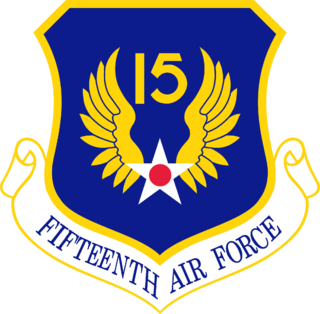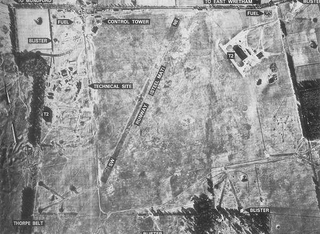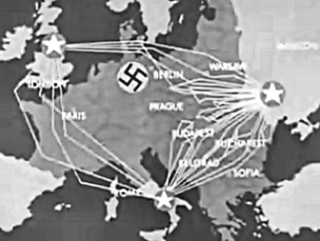Related Research Articles

The Eighth Air Force (Air Forces Strategic) is a numbered air force (NAF) of the United States Air Force's Air Force Global Strike Command (AFGSC). It is headquartered at Barksdale Air Force Base, Louisiana. The command serves as Air Forces Strategic – Global Strike, one of the air components of United States Strategic Command (USSTRATCOM). The Eighth Air Force includes the heart of America's heavy bomber force: the Northrop Grumman B-2 Spirit stealth bomber, the Rockwell B-1 Lancer supersonic bomber, and the Boeing B-52 Stratofortress heavy bomber aircraft.

The Fifteenth Air Force is a numbered air force of the United States Air Force's Air Combat Command (ACC). It is headquartered at Shaw Air Force Base. It was reactivated on 20 August 2020, merging the previous units of the Ninth Air Force and Twelfth Air Force into a new numbered air force responsible for generating and presenting Air Combat Command’s conventional forces.
Operation Argument, after the war dubbed Big Week, was a sequence of raids by the United States Army Air Forces and RAF Bomber Command from 20 to 25 February 1944, as part of the Combined Bomber Offensive against Nazi Germany. The objective of Operation Argument was to destroy aircraft factories in central and southern Germany in order to defeat the Luftwaffe before the Normandy landings during Operation Overlord were to take place later in 1944.

Royal Air Force Metfield or more simply RAF Metfield is a former Royal Air Force station located just to the southeast of the village of Metfield, Suffolk, England.

The Schweinfurt–Regensburg mission was a strategic bombing mission during World War II carried out by Boeing B-17 Flying Fortress heavy bombers of the US Army Air Forces on August 17, 1943. The mission was an ambitious plan to cripple the German aircraft industry; it was also known as the "double-strike mission" because it entailed two large forces of bombers attacking separate targets in order to disperse fighter reaction by the Luftwaffe. It was also the first American shuttle mission, in which all or part of a mission landed at a different field and later bombed another target before returning to its base.

Royal Air Force Horsham St Faith or more simply RAF Horsham St Faith is a former Royal Air Force station near Norwich, Norfolk, England which was operational from 1939 to 1963. It was then developed as Norwich International Airport.

Royal Air Force East Wretham or more simply RAF East Wretham is a former Royal Air Force station located 6 miles (9.7 km) northeast of Thetford, Norfolk, England.

Operation Frantic was a series of seven shuttle bombing operations during World War II conducted by American aircraft based in Great Britain and southern Italy, which landed at three Soviet airfields in the Ukrainian SSR. From there, the planes flew bombing missions en route back to their bases in Italy and Great Britain.

Royal Air Force Tibenham or more simply RAF Tibenham is a former Royal Air Force station located 13.5 miles (21.7 km) southwest of Norwich and 5.8 miles (9.3 km) north of Diss, Norfolk, England.

The 357th Fighter Group was an air combat unit of the United States Army Air Forces during the Second World War. The 357th operated P-51 Mustang aircraft as part of the U.S. Eighth Air Force and its members were known unofficially as the Yoxford Boys after the village of Yoxford near their base in the UK. Its victory totals in air-to-air combat are the most of any P-51 group in the Eighth Air Force and third among all groups fighting in Europe.

Jagdgeschwader 3 "Udet" was a Luftwaffe fighter wing of World War II. The Geschwader operated on all the German fronts in the European Theatre of World War II. It was named after Ernst Udet, an important figure in the development of the Luftwaffe, in 1942.
Jagdgeschwader 300 was a Luftwaffe fighter-wing of World War II. JG 300 was formed on June 26, 1943 in Deelen as Stab/Versuchskommando Herrmann, from July 18, 1943 as Stab/JG Herrmann and finally renamed on August 20, 1943 to Stab/JG 300. Its first Geschwaderkommodore was Oberstleutnant Hajo Herrmann.

The 700th Airlift Squadron is part of the 94th Airlift Wing at Dobbins Air Reserve Base, Georgia. It operates Lockheed C-130 Hercules aircraft providing global airlift.

The 701st Airlift Squadron is part of the 315th Airlift Wing at Charleston Air Force Base, South Carolina. It operates Boeing C-17 Globemaster III aircraft providing global airlift.
Jagdgeschwader 301 was a Luftwaffe fighter-wing of World War II. The order to form JG 301 was issued on 26 September 1943 and formed on 1 October 1943 in Neubiberg with Stab and three Gruppen (groups) as a "Wilde Sau" single-seat night fighter unit.

The 445th Operations Group is the flying component of the 445th Airlift Wing, assigned to Fourth Air Force of the United States Air Force Reserve. The group is stationed at Wright-Patterson Air Force Base, Ohio.

The 702d Expeditionary Airlift Squadron is a provisional United States Air Force unit. It is assigned to Air Combat Command to activate or inactivate as needed. It was active at Kandahar Airfield from 2011 to 2012.

The 703d Tactical Air Support Squadron is an inactive United States Air Force unit. It was last assigned to the 507th Tactical Air Control Wing at Shaw Air Force Base, South Carolina, where it was inactivated in June 1988.

The Air battle over the Ore Mountains took place around midday on 11 September 1944 between German and American air forces over the crest of the Ore Mountains near the village of Oberwiesenthal, above the Bohemian market town of Schmiedeberg.
References
- 1 2 3 4 5 Overview of the Kassel Mission at www.kasselmission.org. Retrieved 17 Sept 2019.
- ↑ Martin Heinzelmann, Göttingen im Luftkrieg 1935–1945, Göttingen: Verlag Die Werkstatt, 2003, p. 44. ISBN 3-89533-424-3
- ↑ Mission Map at www.kasselmission.org. Retrieved 17 Sept 2019.
- ↑ "The disaster of the 445th Bomber Group of the 8th USAAF (German)". barrierefrei.ludwigsau.de. Archived from the original on 8 July 2012. Retrieved 20 Oct 2017.
- ↑ "Ludwigsau – Fliegergedenkstätte der Gemeinde Ludwigsau". ludwigsau.de. Retrieved 20 Oct 2017.